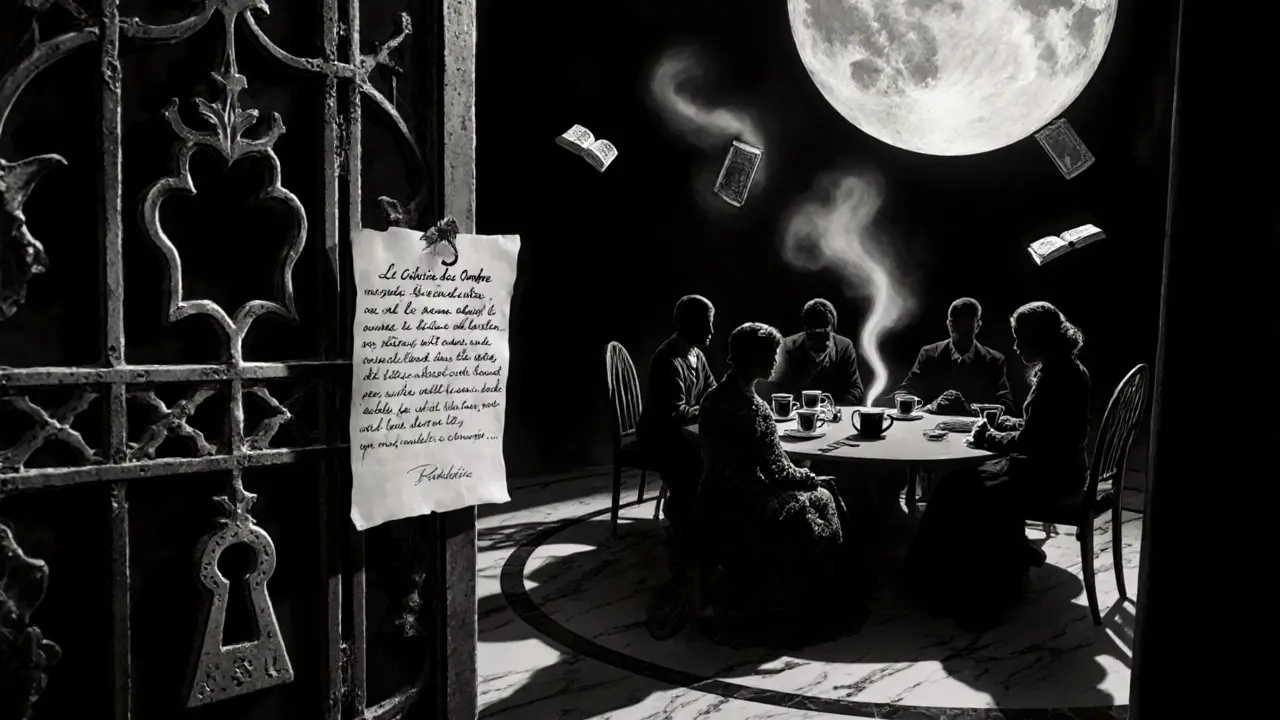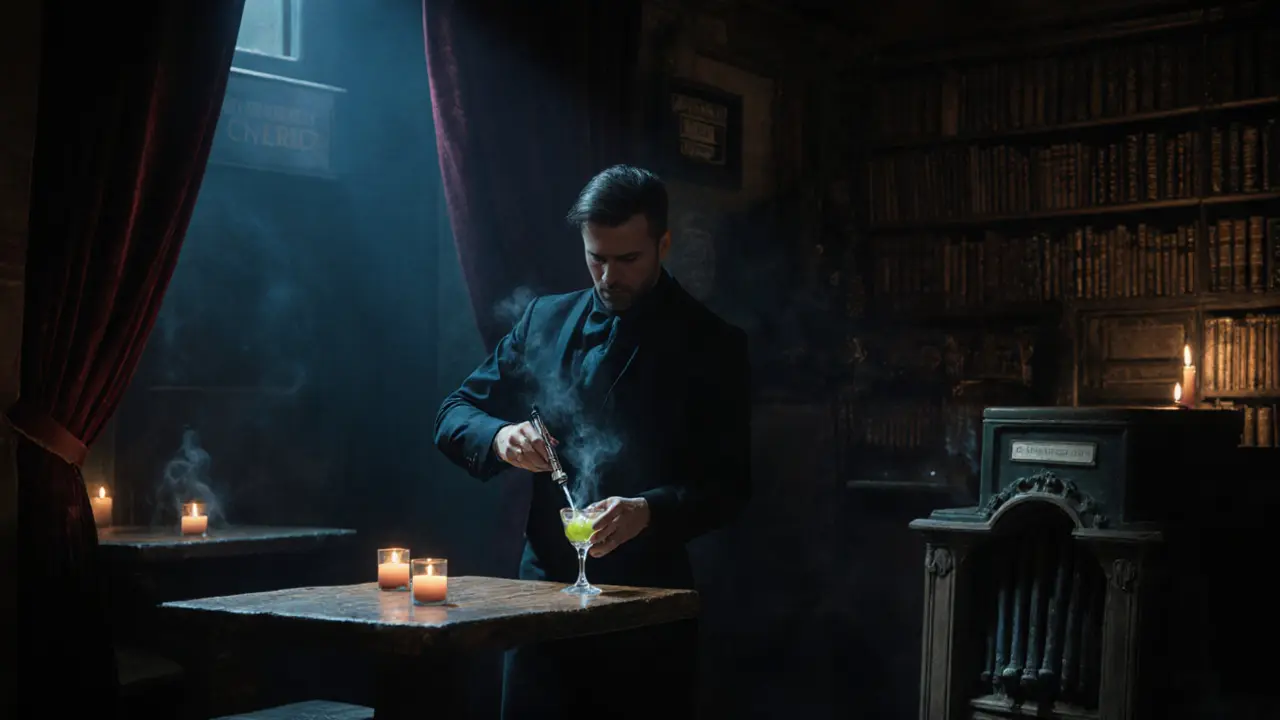Paris isn’t just about croissants and the Eiffel Tower. After midnight, when the tourist crowds vanish and the Seine reflects only the glow of streetlamps, a different city wakes up. This is the Paris of velvet curtains, candlelit crypts, and bass-heavy beats echoing through 17th-century cellars. If you’ve ever wondered where the goths, poets, and midnight dreamers go when the museums close, you’re not alone. The darker side of Paris doesn’t hide-it waits. And it’s more alive than ever in 2025.
Where the Shadows Have Names
You won’t find gothic nightlife on the Champs-Élysées. It’s tucked behind unmarked doors in Le Marais, beneath church ruins in Montmartre, and inside former mortuaries turned jazz dens in the 13th arrondissement. The first rule? Don’t look for signs. Look for silence. The best spots don’t advertise. They whisper.
Take Le Chien Qui Fume-a basement bar under a shuttered bookstore on Rue des Rosiers. The walls are lined with old medical texts, and the bartender pours absinthe from a silver syringe. No menu. You tell him what mood you’re in, and he serves you something that tastes like smoke and regret. Locals say it opened in 1998 as a secret meeting place for poets who refused to write happy endings. Today, it’s still that. No photos allowed. No music louder than a heartbeat.
Then there’s La Crypte des Larmes, hidden beneath a 19th-century chapel turned funeral parlor. The ceiling is painted with faded angels, and the floor is made of reclaimed tombstones. The DJ spins post-punk from vinyl records dated 1984-1992. No one dances. Everyone stands still, eyes closed, letting the bass vibrate through their ribs. This isn’t a club. It’s a ritual.
The Vampires Aren’t Fiction Here
Paris has a vampire scene. Not the sparkly kind. The real ones-the ones who drink black tea with a drop of blood syrup, wear lace gloves in summer, and believe the moon controls their pulse. You’ll find them at Le Cimetière des Ombres, a private salon that only opens on full moons. Entry requires a handwritten note, slipped under the door before midnight. No IDs. No passwords. Just a line from a Baudelaire poem.
They don’t call themselves vampires. They call themselves Les Veilleurs-the Watchers. They gather to read forbidden poetry, share dreams they’ve had the night before, and discuss the ethics of immortality. One regular, a 72-year-old librarian named Élodie, says she’s been coming here since 1987. “We don’t drink blood,” she told me. “We drink silence. And that’s harder to find.”
There’s a reason this culture thrives in Paris. The city’s history is soaked in death. The Catacombs hold six million skeletons. The Père Lachaise Cemetery is the most visited necropolis on Earth. People here don’t fear the dark-they’ve made peace with it. And that peace? It’s contagious.
Music That Feels Like a Funeral Waltz
The soundtrack to Parisian gothic nightlife doesn’t come from Spotify playlists. It comes from analog synths, pipe organs, and cellos played in rooms with no windows. In 2025, the most talked-about venue is La Salle des Morts, a converted 1800s morgue in the 10th arrondissement. The walls still have metal hooks where bodies once hung. Now, they hold vintage microphones.
Every Friday, a band called Les Voix du Froid plays live. Their music blends industrial noise with French chanson. The lead singer wears a mask made of human hair and sings in a language no one can translate. Critics call it “the sound of a ghost remembering how to cry.”
Don’t expect dancing. Expect stillness. People come here to feel something real. A 28-year-old student from Lyon told me he came three times last month. “I lost my sister last year,” he said. “This place doesn’t fix anything. But it doesn’t pretend it should.”

Drinks That Taste Like Midnight
The drinks here aren’t cocktails. They’re experiences. At Le Verre Noir, a bar hidden behind a bookshelf in Saint-Germain-des-Prés, the bartender mixes drinks using ingredients like crushed violet petals, smoked salt, and tinctures made from black garlic and elderberry. The signature drink? Le Dernier Soupir-a dark liqueur served in a chalice shaped like a skull. You sip it slowly. The flavor changes with every drop: first bitter, then sweet, then metallic. Like memory.
Another favorite is La Table du Néant, a speakeasy where every drink comes with a tarot card. Pull one before you order. The bartender interprets it, then crafts a drink based on your fate. “The Moon” gets a lavender-infused gin with a drop of absinthe. “The Tower” gets a shot of black pepper whiskey and a single drop of ink.”
There’s no alcohol on the menu. No prices listed. You pay with stories. Bring one worth telling.
How to Find These Places (Without Getting Lost)
You won’t find these spots on Google Maps. They’re not listed on TripAdvisor. But they’re not secret, either. They’re just quiet.
Here’s how to find them:
- Walk the streets of Le Marais after 11 p.m. Look for doors with no handles-just keyholes shaped like ravens or moons.
- Ask a local artist, not a tour guide. Head to the book stalls along the Seine at dusk. The ones selling old poetry collections? They know.
- Visit the Musée des Arts Forains during the day. The staff sometimes hand out cryptic tickets to nighttime events.
- Follow the scent of incense and damp stone. It leads to places no one else finds.
- Don’t bring your phone. Many of these places block signals. If you need to be found, leave a note on a bench near the Pont Alexandre III. Someone will pick it up.
And if you’re lucky? You’ll be invited. No invitation needed. Just presence. Silence. And the willingness to let the night change you.

What to Wear (And What to Leave Behind)
There’s no dress code. But there’s a code. Wear black. Not because it’s trendy. Because it absorbs the light. Velvet, lace, leather-materials that feel like they’ve been worn before. Shoes should be quiet. No heels. No sneakers. Just soft soles that don’t echo.
Leave your camera, your selfie stick, your Instagram feed. These places don’t want to be seen. They want to be felt. The only photo you’ll take? The one you remember.
When to Go
Weekends are crowded. Not with tourists-with locals who’ve been coming for decades. If you want the real experience, go on a Tuesday or Wednesday. That’s when the energy shifts. The music slows. The candles burn lower. And the stories get deeper.
October through February is the season. The nights are long. The fog rolls in off the Seine. The city feels like it’s holding its breath. That’s when the gothic soul of Paris is most visible.
Why This Matters
Paris’s gothic nightlife isn’t about rebellion. It’s about remembrance. In a world that rushes, these places ask you to pause. To listen. To sit with the weight of history, loss, and beauty that doesn’t need to be pretty to be true.
People come here not to escape reality-but to find a version of it that’s been carved out of silence and shadow. It’s not for everyone. But if you’ve ever felt like you don’t belong in the daylight? This is where you’ll find your people.
Is Gothic nightlife in Paris safe?
Yes, but only if you respect the space. These venues are run by locals who’ve built trust over decades. Violence is rare. Disrespect is not tolerated. Don’t take photos, don’t be loud, don’t try to sell your story. Be quiet. Be present. That’s the only rule.
Do I need to dress in goth fashion to enter?
No. But you’ll stand out if you wear bright colors or sportswear. Most people wear black, dark tones, or vintage fabrics. It’s not about costumes-it’s about blending into the mood. If you feel comfortable in dark, quiet clothes, you’ll fit right in.
Are these places expensive?
Prices vary. Some places charge €15-25 for a drink. Others don’t have prices at all. At Le Verre Noir, you pay what the story is worth to you. Some leave €5. Others leave €50. It’s not about money. It’s about meaning.
Can I visit during the day?
Most of these places are closed during daylight. But some, like La Salle des Morts, host afternoon poetry readings or art exhibits on weekends. Check their Instagram accounts-though many don’t update often. The best way is to ask in person at nearby bookshops or cafés in Le Marais.
Is this just a tourist gimmick?
No. Tourists are welcome-but they’re not the point. The core of this scene has existed since the 1980s. It’s maintained by artists, writers, and mourners who refuse to let Paris forget its ghosts. If you’re looking for fake vampires and neon lights, you’re in the wrong place. This is real. And it’s been here long before you were born.
If you’re ready to see Paris after dark-not as a postcard, but as a living, breathing, haunted soul-then go. Bring your silence. Bring your questions. And don’t expect answers. Just let the night answer for you.




